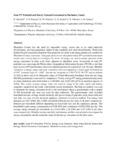| dc.description.abstract | Machakos County has the need for renewable energy access due to its rapid industrial development, growing population, higher living standards and rural electrification. Wind-solar hybrid off-grid system has therefore been proposed for small scale energy production suitable for Machakos County rural areas. This paper presents the solar photovoltaic (PV) potential assessment results and a survey done to investigate the levels of energy use, and economic potential of the energy consumers in three rural zones adjacent to Machakos town. Assessment of solar PV potential was done using the Photovoltaic Geographical Information System (PVGIS), a tool that gives access to PV performance and solar radiation patterns for a period of over 10 years. Monthly variations in energy output and solar irradiation were investigated at a fixed angle of Inclination of 10, Azimuth angle of −180 , latitude and longitude of 1.531 S 37.262 E, and an altitude of 1623 m above sea level. Measured values of Global Horizontal Irradiance from the site using MS-602 pyranometer were used for comparison. Yearly average PV energy production and yearly in-plane irradiation were determined as 1740 kWh and 2130 kWh/mat an installed capacity of 1kWp. This yearly average energy value was used in sizing of the solar panels and battery capacities required for the wind- solar hybrid system installation. The End-use method was used to determine the energy utilization levels in the rural homes where a questionnaire with a sample of 100 households per zone was used for data collection. The questionnaire items included household income, average month electricity bill, power rating of appliance used, house hold size and daily use time of each electrical appliance collected via end-use method. The energy load demand was 782.7 kWh, 841.2 kWh and 620.02 kWh per day for zones A, B and C respectively. Demand per household differed depending on household size and the appliances present. The household’s peak energy consumption was 9.09 kWh and a minimum of 0.052 kWh per day. The average energy demand per household was 2.429 kWh, 2.26 kWh and 2.347 kWh in the three zones respectively. Monthly income and daily load demand profiles were plotted to investigate the energy use patterns and the economic status of the energy consumers in the three zones. | en_US |

